#seewiefken
Explore tagged Tumblr posts
Text
Similarities of Folklore in H2O: Just Add Water
Previously I did a post on Cleo's bathtub transformation and how it's a previous motif in some legends. I now want to dive into the rest of the folklore that can be fished out of the show. Many parallels are not directly the same, but still share some interesting origins. First, let's look at the powers.
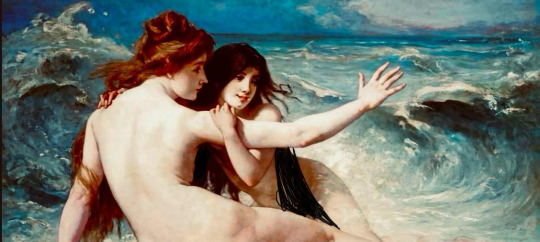
Edited and cropped "Sous la Vague" or "Les Baigneuses" by Nicolas Auguste Laurens in 1898.
1: Cleo's hydrokinesis can be found in many waterpeople. Almost all humanoid water deities across the world are able to bend water to some extent, many of would would be countless to name in one post. For instance, Poseidon/Neptune was said to be able to control the seas. Triton could calm and raise the waves of the sea with the blow of his conch shell. Aside from water deities themselves, other waterpeople were able to control water. According to "Scaled for Success: The Internationalisation of the Mermaid" on page 108, the Filipino sirenas were said to be able to control water "by manipulating water levels and/or create whirlpools to swamp their prey". According to "Mermaids: The Myths, Legends, and Lore" on page 180, the Filipino kataws control the waters around the Philippine Islands, namely its "tides, currents" and even the "movements of the aquatic creatures". The Asturian xanas were in charge of keeping rivers and fountains calm according to: Mitología Asturiana - Marsellaviana on Freehostia under the llavanderes or washerwomen entry http://marsellaviana.freehostia.com/mitologiaasturiana/seresmitologicos.html
One xana in particular was able to flood as she supposedly flooded the town of Gayangos and created an entire lagoon and the lakes in the area according to: La leyenda de la Xana de Gayangos - La Cantabria Burgalesa https://lacantabriaburgalesa.wordpress.com/2016/12/03/la-leyenda-de-la-xana-de-gayangos/
Asturian llavanderes, basically mythical washerwomen, were able to summon floods and create whirlpools according to the aforementioned Marsellaviana site.
Another mermaid is the seewief or seewiefken of German folklore in Minsen. She once got caught in the net of some fishermen and got tormented, yet she eventually escaped. In revenge, she cast a curse and created storm floods in the years of 1164, 1362, 1717 and 1962 that hit Minsen. This is told according to: The Minsen Mermaid Statue - a Seewief from the Middle Ages https://mermaidsofearth.com/mermaid-statues-mermaid-sculptures/public/minsen-mermaid-statue-seewief/ (This sourced some other sites, but they are gone), Die Sage from Minsener Seewiefken - NAKUK https://www.nakuk.de/wiki/seewiefken/, Seewiefken - Wangerland https://www.wangerland.de/poi/seewiefken and Das Minsener Seewiefken Vom Fluch der Meerjungfrau - NWZ Online https://www.nwzonline.de/kultur/minsen-das-minsener-seewiefken-vom-fluch-einer-meerjungfrau_a_50,6,796560382.html
Yet another is the zeemermann of the Saeftinghe legend in the Netherlands. A zeemermin once got caught by a fisherman who refused to let her go. Her husband swam after the boat, yet to no avail. He cursed Saeftinghe and flooded the land. It was said that only Saeftinghe's towers would remain. Now, the land, it's called the drowned land of Saeftinghe. This is told according to "The Mermaid Atlas - Merfolk of the World" by Anna Claybourne on page 31 and Wandelen in het verdronken land van Seaftinghe - JNM https://jnm.be/nl/activiteiten/wandelen-in-het-verdronken-land-van-seaftinghe
~~~
2: Rikki's fire power: Waterpeople can be associated with fire, the sun or warmth despite inhabiting the water. (Added note: Originally, I did not acknowledge that). In Thai folklore exists the so-called Phi thale ผีทะเล sea spirit who is able to appear as a mermaid or a beautiful woman who can lure sailors to their demise. Sometimes a Phi Thale takes form as a St. Elmo's fire, basically a weather phenomenon caused by electrical discharges during thunderstorms. It seems to appear like faint luminosity or "fire" and in context of the Phi Thale it might, for example, take place on a ship's mast as shown on the illustration, but one is not absolutely shore. St. Elmo's fire also appears in many other forms like on church towers. Phi Thale description is from: What is a Phi Thale (ผีทะเล)? - PAHUYUTH https://pahuyuth.com/en/glossar/phi-thale/ and information on the Saint Elmo's Fire - Britannica https://www.britannica.com/science/Saint-Elmos-fire
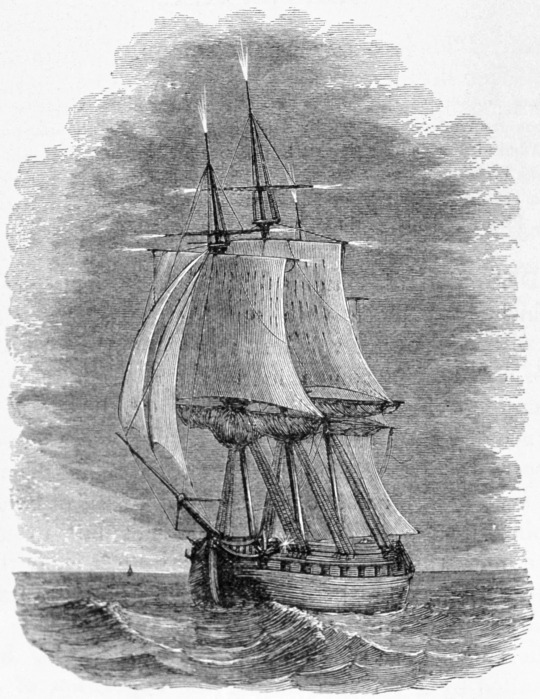
Illustration from "The Aerial World" by Dr. G. Hartwig in 1886 on page 310.
Sulis is a Celtic water goddess from the United Kingdom who is still associated with the sun and is thus both a water and solar deity. She was also associated with the hot springs in Bath according to Sulis, Goddess of Celtic Mythology | Characteristics & Depictions - Study. com https://study.com/academy/lesson/sulis-celtic-goddess-mythology-history.html?srsltid=AfmBOopQslCH2QEArMfaq5VE7QDgXuMQS3z55jnppUGbVGlpA3E7ldu2.
The lakes of the Catalan freshwater-maidens called the dones d'aigua were said to boil if a stranger would dive into them, yet this is only said on Wikipedia without a source and until I do not have found any good source for this, please do not claim it as fact.
The Portuguese water-maiden Maria da Manta meaning "Mary of the Blanket", Maria Gancha namely "Mary Hook", Maria Ganta meaning "Mary of the Grid" or as in the Miranese language, Mariamanta, was said to live in wells. While her appearance varied a lot, some would say she possessed eyes made of fire despite living in the waters of wells according to: Maria Gancha - Portuguese Creatures and Legends Galore https://portuguesecreaturesandlegendsgalore.wordpress.com/2020/02/14/maria-gancha/
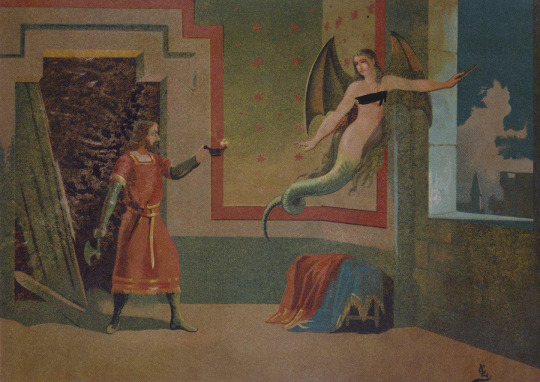
Illustration for "Las Supersticiones De La Humanidad" by Jose Coroleu in 1881.
Melusine from French folklore is sometimes said to grow wings when she flies away in the legend and therefore is sometimes considered to be a literal dragon-maiden either with one or two fishtails and sometimes only with a serpent tail depending on the version. She is both considered a watermaid and a dragon-maid in different versions because of that.
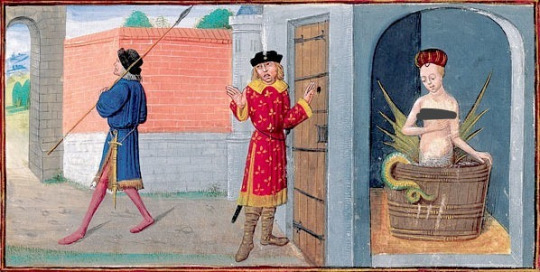
Illustration from "Le Roman de Mélusine" in ca. 1450-1500.
An enchanted xana could also turn into a cuélebre, namely a snake-like dragon, in order to be disenchanted. Her savior must perform some tasks so that she would be able to be free from her spell, turn back into a xana or a normal human being and be freed from being bound to her lair. This disenchantment is really complex and one can find a wide sea of different methods. One source of mine is: Some thoughts on Asturian Mythology - David A. Wacks https://davidwacks.uoregon.edu/2014/12/12/asturian/. In spite of that, both of these dragon-turned watermaids didn't emit fire from their mouths. I still included them because it shares a little of the fire aspect due to their dragon forms.
~~~
3: Emma's ice power: Plenty of waterpeople live in colder waters, but do not possess the power to manipulate water and turn it into ice. The only mention one ever heard of are the Filipino kataws who can also turn water into ice according to this Wikipedia article https://en.wikipedia.org/wiki/Kataw_(Philippine_mythology) that sourced "Mga Engkanto: A Bestiary of Filipino Fairies. Philippines: eLf ideas Publication. 2003". It's probably a privately published book as I can only find a Blogspot post about its concept idea. Would like to confirm the source, but as of now one does not have the book.
~~~
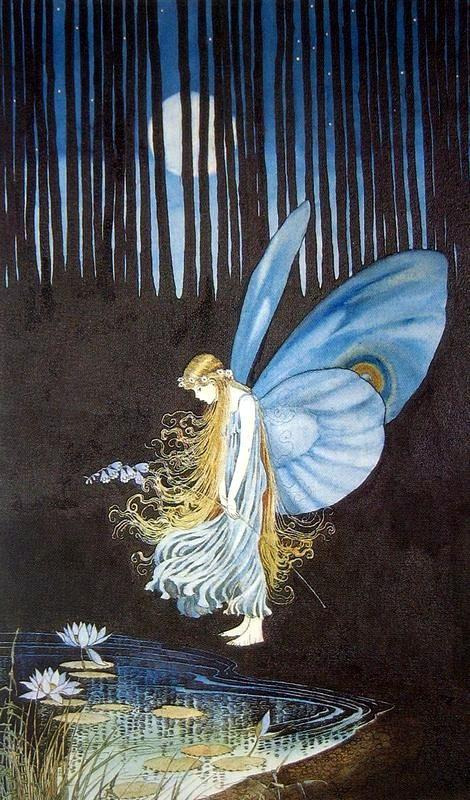
"The Last of the Fairies" by Ida Rentoul Outhwaite (1888-1960)
4: Simply the moon or the full moon: Waterfolk has a relationship to the full moon. There is no moon pool or a direct moon spell affecting waterfolk, yet Catalan dones d'aigua tended to only show up on full moon nights where they would come out of their caves to dance, to comb their hair and to wash their laundry. Some would only sing on full or new moon nights, maybe they got spell-bound by the moon? Who knows. This is told according to: Les dones d'aigua - Elisenda Vilaró Móra http://www.elisendavilaromora.com/2012/03/les-dones-daigua/, Llegendes del riu i les done's d'aigua - Turisme Les Planes D'Hostoles https://turismelesplanes.cat/localitzacions/el-riu-i-les-dones-daigua/, Llegendes: Dona D'Aigua - Generalitat de Catalunya Departament d'Educació https://agora.xtec.cat/ceipcamins/4t/llegendes-dona-daigua/, Llegenda de les Dones d'Aigua - Mapes de Patrimoni Cultural https://patrimonicultural.diba.cat/element/llegenda-de-les-dones-daigua, Les dones d'aigua en la tradició popular - Mitologia Catalana Blogspot https://mitologiacatalans.blogspot.com/2016/09/les-dones-daigua-en-la-tradicio-popular_23.html and Mitologia Catalana - Isaac Baley https://www.isaacbaley.com/mitologia-catalana.html
One xana was said to be only present on full moon nights, dancing in the forest. This is said according to: La leyenda de La Xana: una historia de amor en Asturias - Crónica Asturias https://cronicaasturias.es/blog/la-leyenda-de-la-xana-una-historia-de-amor-en-asturias
Atargatis is one of the earliest waterfolk deities aside from the kullulû of Mesopotamia. She's an Assyrian fertility and mermaid goddess, yet was also described to be a moon goddess according to "Mermaids: The Myths, Legends, and Lore" on page 78.
The selkies were also said to go ashore on full moon-lit nights to shed their sealskins and dance at the seaside.
~~~
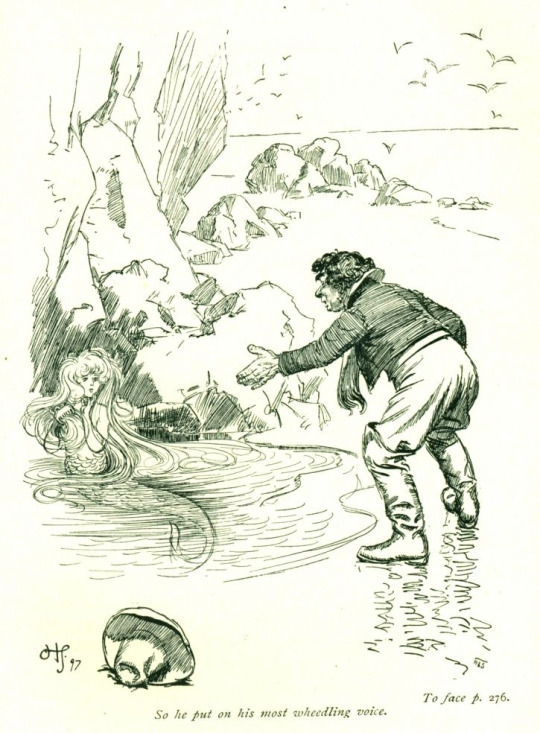
Illustration by Hugh Thomson for "Highways and Byways in Devon and Cornwall" in 1897.
5: The granting wishes ability from episode 5 "Hocus Pocus" on season 2: In the Cornish legend of Lutey Curry and the merry-maid, the merry-maid was said to have given Lutey three wishes as he had helped her go back into the water from being beached ashore. He wished for the power to heal the sick, the power to "defuse wicked spells" and to have his powers passed on after his death according to "Mermaids: The Myths, Legends, and Lore" on page 102 and Curses, Vengeance, and Fishtails: The Cornish Mermaid in Perspective https://www.academia.edu/31865439/Curses_Vengeance_and_Fishtails_The_Cornish_Mermaid_in_Perspective
The Scottish ceasg or maid-of-the-wave was also said to grant one three wishes if one caught her and then released her again according to #FolkloreThursday: The Ceasg - Steampunklibrarian Blog https://steampunklibrarian.blog/2021/09/30/folklorethursday-the-ceasg/ and Gaelic Folklore (5): Ceasg - Nicovleeuwen https://nicovleeuwen.blogspot.com/2019/06/gaelic-folklore-5-ceasg_7.html
~~~
6: The shapeshifting from mermaid to human is something prevalent in folklore, but not at the simple touch of a water drop. Instead, primarily only if the lower half is fully submerged, basically when fully going into a water body. Most waterfolk only have a fishtail that they can discard and wear later on again like a piece of clothing, but some do fully shapeshift like the mermaids of the show do. According to "Mermaids: The Myths, Legends and Lore" on page 181, the fishtailed yawkyawks from the mythology of the Kuninjku people in Australia could go ashore and "sprout legs and seem to be wholly human".
~~~
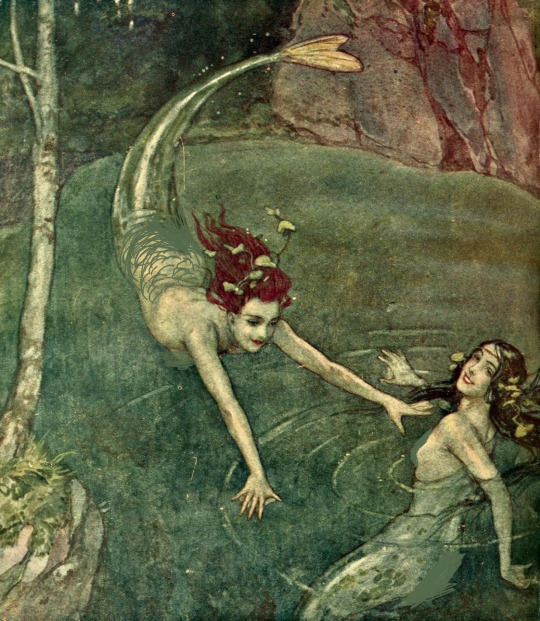
Edited “Unter-Wasser-Philosophie” by Erich Schütz for Mocca in 1934. Yawkyawks were said to have green hair resembling green algae in freshwater streams and rock pools, called man-bak in Kuninjku according to Yawkyawk (Ngalkunburriyaymi) - Maningrida Arts and Culture https://maningrida.com/artwork/683-23/.
As the show is set in Australia, the waterfolk of Australia is another part to consider. Here's a list of the Indigenous Australian watermaid ones. I won't skim through the entirety of their lore due to the fact that there are barely any parallels between them and the show, aside from the yawkyawks who could shapeshift into humans:
< Yawkyawks (other terms: ngalkunburriyaymi, ngalberddjenj (both possibly from the Kuninjku people) ngalworreworre (Wugularr community) from the book "Mermaid and Serpent - A Story from Wugularr Community", and ngalkodjek (Darnkolo people) as from: Owen Yalandja: Ngalkodjek Yawkyawk 2019 - ARTKELCH - Contemporary Aboriginal Art https://www.artkelch.de/en/artists/owen_yalandja_216/works/ngalkodjek_yawkyawk_1827
< The pearl-givers or the mermaids of the Keppel Islands of the Woppaburra people are found in "Among the Mermaids: Facts, Myths, and Enchantments from the Sirens of the Sea" on pages 98-99.
< The Ji-merdiwa from the Burarra people near the Blyth river can be found on: Mermaids tales appear in myths across the world- Arnhem Land included by Anna Whitfeld - ABC News https://www.abc.net.au/news/2018-06-11/mermaids-across-the-world-arnhem-land/9846210
< Wíwa spirits (mermaid spirits) from the Kunibídji people and Djómi and Bábbarra, and the other successor Djómi spirits: Our Bedtime Stories Episode 8: Djómi (Mermaid Story) - ICTV Play https://ictv.com.au/video/item/5508?lp=1, Djomi ( Fresh Water Spirit) Bábbarra Women's Centre https://babbarra.com/design/djomi/
< The karukayn of the Gurindji people as told in “The Penguin Book of Mermaids” on pages 224-225
< and the Muli Kanybubi from the Marri Ngarr Yek Dirrangara people as told in “Muli Kanybubi Tjitjuk Kawuny Na Yagatiya - The Two Mermaids’ Dreaming Place”.
More resources on the Indigenous Australian watermaids: Mermaids in Folklore & Australian Indigenous Culture - troublemag https://www.troublemag.com/mermaids-in-folklore-australian-indigenous-culture/ and H2O: Just Add Water and myth of mermaids in Australia - Anglophone Literatures Blog https://blogs.phil.hhu.de/anglophoneliteratures/2022/04/04/h2o-just-add-water-and-myth-of-mermaids-in-australia/
Whether intentional or not, the lore is pretty deep.
(If any sources are not able to be viewed, consult an archival site)
Re-published and re-polished from the edited original entry on reddit via r/JustAddWater: https://www.reddit.com/r/JustAddWater/comments/1f934vx/similarities_of_folklore_in_the_show/
In the original entry, I had wanted to include these depictions that can be seen here, but it got removed. I am not shore what the culprit was, but it may have been the second or latter depiction of Melusine as I did not edit it back then since I thought it would be tolerated because no chest was directly visible. On the un-edited version of the depiction, her chest was already obscured by a light spot that looks like as if the paper had been ripped.
#mermaid#mermaids#folklore#waterfolkology#h2o just add water#h2o mermaid#h2o#cleo sertori#rikki h2o#rikki chadwick#emma h2o#cleo h2o#emma gilbert
14 notes
·
View notes
Text
We par example have the male nix and female nixe like the Nixe Saala. We have the seewief or seewiefken in Minsen. Includingly, we have the hakemann. The Ekke Nekkepenn from Sylt alongside. We also have the Vineta legend from Barth, a legend of a city with its people living under the sea. This is just a list of some of them. For one's information, the Lorelei is not a waterperson from folkloric oral tradition. Clemens Brentano firstly created the Lore Lay as a fictional character. Heine Heinrich was the one who first mentioned her in a way we know of today, thus she is more likely better referred to as being a literary waterperson. All previous legends regarding the Lorelei stone were just about dwarfs, nymphs, or mountain-ghosts, but no waterperson or Lorelei directly.
I was chatting with @mercutao about mermaids - as one does - and was just introduced to the rusalka from slavic folklore
which prompted me to talk about my people's version of a water spirit/merperson which is the boto cor-de-rosa from brazilian folklore
and then I found this super cool book called Fantastic Creatures in Mythology and Folklore
anyway, have some highlights:



13 notes
·
View notes
Photo






Das Minsener Seewiefken und der Blick nach Wangerooge
#minsen#seewiefken#wangerooge#wangerland#friesland#sonnenuntergang#sunrise#nordsee#seejungfrau#abendstimmung
3 notes
·
View notes